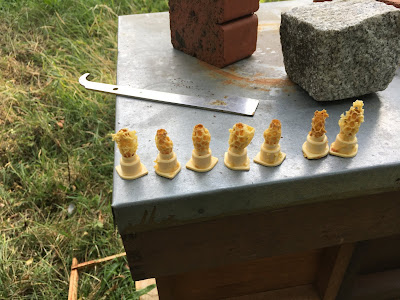I have read many books, articles, blogs and watched countless internet videos on queen rearing. While this is very worthwhile it can become mind boggling. The different methods become blurred and confused. I think that if you want to rear queens and to develop onto bee breeding, you should choose a method, research that method and give it a try. That is to say a few attempts, rarely does a single attempt produce the results show the true potential that can be attained. Lessons can be learned from failure and successes built upon. Then by all means move onto try another method.
I found a number of videos that I found fascinating and informative, Even before I actually had any bees myself. These were on the National Honey Show's YouTube channel. They had invited Mike Palmer from North America to speak. There are a few videos if his talks on their channel, one of these in particular I have watched over and over, this his talk on Queen Rearing in the Sustainable Apiary, Link I decided to base my queen rearing on the method that Mike describes.
Inorder to raise queen cells the cell raiser needs to be strong in numbers of bees, with a high number of young nurse bees and to be congested, that is packed with bees, so many that it seems that there is hardly enough room in the cell raiser to accommodate them all. The video describes how to prepare a colony to be a cell raiser by adding frames of sealed brood to an already strong colony and then to split what has now become a colony that is ready to swarm into a separate cell raiser and a queen right "half" that can be reunited after queen rearing.
After this manipulation of the colony to produce the hopelessly queenless cell raiser, it should be left for a few hours for the bees to realise that they have no queen or larvae with which to raise another queen.
 |
| Hopelessly queenless |
 |
| Packed with bees |
Ten days after grafting it is time to harvest the ripe queen cells, these can be used in a number of ways. I introduce them into either full size framed nucs or Apideas.
 |
| Apideas to be transported to the mating apiary. |
 |
| Nucs and Apideas in the mating apiary |
 |
| Virgin queens have emerged from these cells |
 |
| A new queen! |
With luck you will have new queens from your own stock that will go onto hopefully, to reward your efforts with gentle colonies that are a pleasure to work, give a good honey crop and give you a great deal of satisfaction. The queen in the above picture gave me my biggest honey crop in 2018 but unfortunately wasn't as easy to work as I'd hoped! She did her bit though and although I thank her for that she will not be part of next years breeding programme.
No comments:
Post a Comment